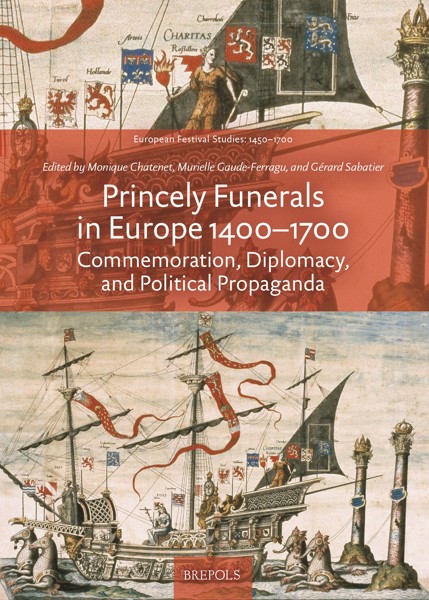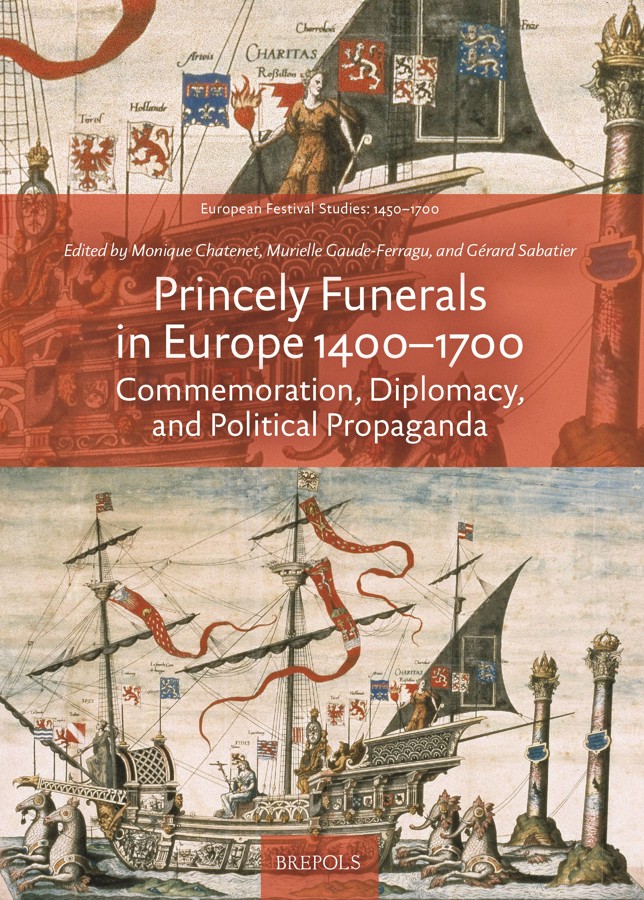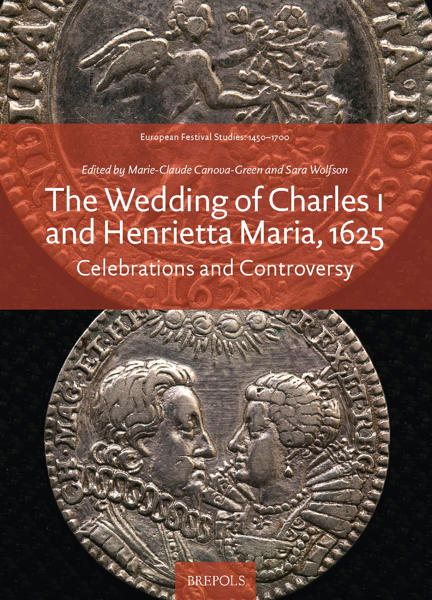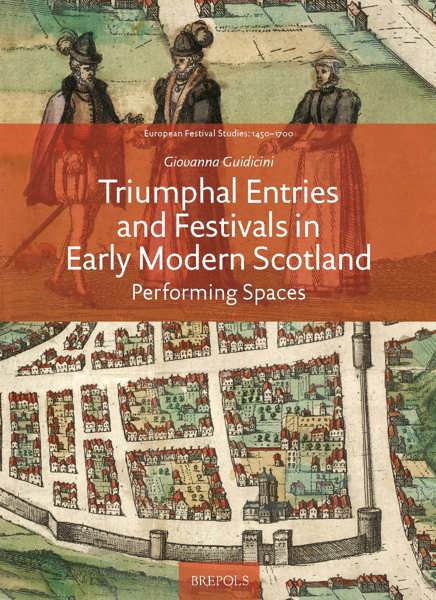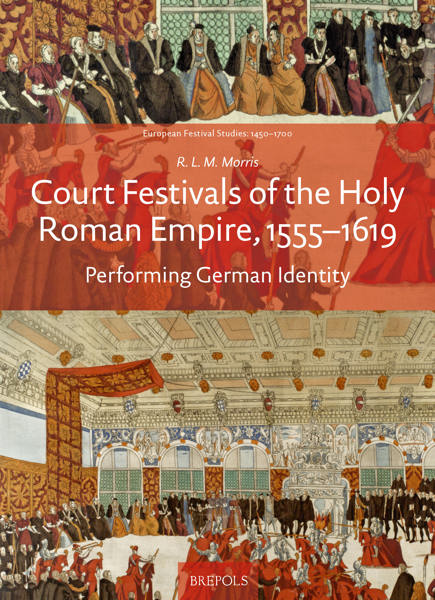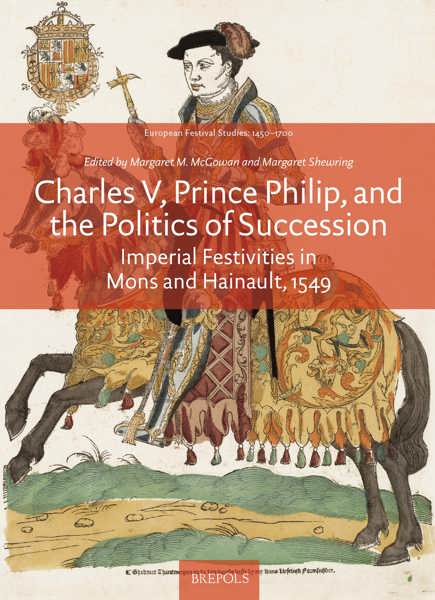
Princely Funerals in Europe, 1400-1700
Commemoration, Diplomacy, and Political Propaganda
Monique Chatenet, Murielle Gaude-Ferragu, Gérard Sabatier (eds)
- Pages: 365 p.
- Size:178 x 254 mm
- Illustrations:60 b/w, 21 col.
- Language(s):English
- Publication Year:2021
- € 90,00 EXCL. VAT RETAIL PRICE
- ISBN: 978-2-503-58743-1
- Hardback
- Available
- € 90,00 EXCL. VAT RETAIL PRICE
- ISBN: 978-2-503-58744-8
- E-book
- Available
Panorama of royal and princely ceremonial, their evolution from the end of the Middle Ages to the seventeenth century and their diffusion throughout the Courts of Europe.
“Overall, this is a useful, compact and well-illustrated reference book. The authors have admirably synthesised prior studies, making them accessible to an English-speaking audience (…)” (ANN J. ADAMS, in Church Monuments, 36, 2021, p. 236)
Monique Chatenet (Docteur HDR in History of Art, conservateur en chef honoraire du Patrimoine)is the author of numerous books and articles on the topics of French architecture of the Renaissance and the life of the court in the Sixteenth Century, including Chambord (2001) and La cour de France au XVIe siècle. Vie sociale et architecture (2002). She has edited many studies on these subjects and published numerous articles on sixteenth-century royal and princely funerals.
Murielle Gaude Ferragu (Agrégée en histoire et docteur ès lettres, is maître de conférences à l'université Paris - XIIIe, Sorbonne-Paris-Cité, and junior member of the Institut Universitaire de France). She is a specialist on princely funerals in Europe, having published her thesis on the topic in 2005, D'or et de cendres. La mort et les funérailles des princes dans le royaume de France au bas Moyen Age. She also works on women in power, (La Reine au Moyen Age, XIV-XVe siècle, 2014 .
Gérard Sabatier (Docteur d'Etat, professeur émérite des Universités - ancien professeur d'histoire moderne à l'Université Pierre Mendès France Grenoble II - président du comité scientifique du Centre de Recherche du Château de Versailles) has participated in the Research programme Genèse de l'Etat moderne (Centre national de la recherche scientifique, 1985-1986, which became the Fondation Européenne de la Science, 1989-1992). His principal publications are Versailles ou la figure du roi (1999); Le Prince et les arts. Stratégies figuratives de la monarchie française de la Renaissance aux Lumières (2010); as editor, Claude-François Ménestrier. Les jésuites et le monde des images (2009); and with M. Torrione, Louis XIV espagnol? Madrid et Versailles: Images et modèles (2009); with J. Chroscicki and M. Hengerer, Les Funérailles princières en Europe XVIe-XVIIIe siècle: vol. 1, Le Grand Théâtre de la mort (2012); vol. 2, Apothéoses monumentales (2013); vol. 3, La mémoire, le deuil et la politique (2015). With Beatrix Saule, he was the organiser of the exhibition at Versailles of Le roi est mort, 26 oct. 2015 - 21 feb. 2016.
Funerals were among the most extravagant princely ceremonies in Europe. At the end of the Middle Ages, they were grandiose affairs, carefully recorded, bringing together the emotions of both Court and People. The Renaissance heightened their effect, adding surprising elements borrowed from an Antiquity which was largely re-invented. The seventeenth century introduced ephemeral displays, elaborately constructed castrum doloris, dressed up with lavish facades and interior designs which transformed these sanctuaries into theatrical funeral pyres.
Historians, anthropologists, and political scientists have long been interested in this subject, as can be seen from Ralph Giesey's celebrated work Le Roi est mort. Art historians have been attracted to the surviving decorations of tombs and funerary chapels. Yet historians of spectacle and of its ephemera have, hitherto, somewhat neglected a topic which is — nonetheless — at the heart of their concerns: with their elaborate settings, their costumes and decors, princely funerals challenge theatre and opera.
It is within this context that experts from many disciplines attempt to trace the evolution of funeral ceremonies, which were much less static than is generally believed; to expose the gifts of the masters of these solemn occasions (and, indeed, of their predecessors, the heralds) who constantly devised subtle ways of capturing the attention of spectators and moving their emotions. These essays have tried to cover not only a wide time spectrum but also to reveal the variety and range of such ceremonies devised in diverse European Courts as well as unravelling the innovations which underlay fashions which had multiple international repercussions.
Featuring contributions by: Monique Chatenet, Murielle Gaude-Ferragu, Gérard Sabatier, Agostino Paracivini_Bagliani, Alain Marchandisse, Joël Burden, Mickaël Boytsov, Maria Nadia Covini, Eva Pibiri, Marie-Madeleine Fontaine, Giovanni Ricci, Gérard Sabatier, Maria Adelaida Allo Manero, Naïma Ghermani, Birgitte B. Johannsen.
Acknowledgements, List of Illustrations, Editors and Contributors
Introduction. The Changing Face of Funerals (1400–1700) — Monique Chatenet, Murielle Gaude-Ferragu, and Gérard Sabatier
Part I. Fifteenth Century, edited by Murielle Gaude-Ferragu
Chapter 1. The Funerary Rite of the Papacy at the End of the Middle Ages—Agostino Paravicini Bagliani
Chapter 2. ‘The Body of the Prince’: Royal and Princely Funerals in Fifteenth-Century France—Murielle Gaude-Ferragu
Chapter 3. The Funerals of the Dukes of Burgundy in the Fifteenth Century — Alain Marchandisse
Chapter 4. English Royal Funerals in the Fifteenth Century —Joel Burden
Chapter 5. Death and Funerals of German Emperors, Kings, and Princes in the Fifteenth Century — Mikhail Boytsov
Chapter 6. Between Visconti and Sforza: Notes on the Funeral Ceremonies of the Dukes of Milan in the Fifteenth Century — Maria Nadia Covini
Chapter 7. The Funerals of the Dukes of Savoy in the Fifteenth Century: Between Austerity and Splendour —Eva Pibiri
Part II. Sixteenth Century, edited by Monique Chatenet
Chapter 8. Funerary Rites and Mysteries held in connection with Treatises on Ancient Funerals in Sixteenth-Century France —Marie Madeleine Fontaine
Chapter 9. Royal and Princely French Funerals in the Sixteenth Century —Monique Chatenet
Chapter 10. Double Funerals and Funeral Effigies in Italian States—Giovanni Ricci
Chapter 11. The Funeral of Charles V — Alain Marchandisse
Part III. Seventeenth Century, edited by Gérard Sabatier
Chapter 12. The Funerals of Louis XIII and Louis XIV —Gérard Sabatier
Chapter 13. Great Funerals in a Little State: Francesco I and Alfonso IV d’Este at Modena (1659 and 1663) —Giovanni Ricci
Chapter 14. Philip IV of Spain: Projecting Royal Majesty through Funeral Ceremonial — Maria Adelaida Allo Manero
Chapter 15. The Funeral of Maurice of Hesse-Kassel (1632): Dynastic or Denominational Theatre?—Naïma Ghermani
Chapter 16. Staging the Queen’s Funeral in Seventeenth-Century Denmark: The Case of Sophie Amalie of Brunswick-Lüneburg — Birgitte B. Johannsen
Index
